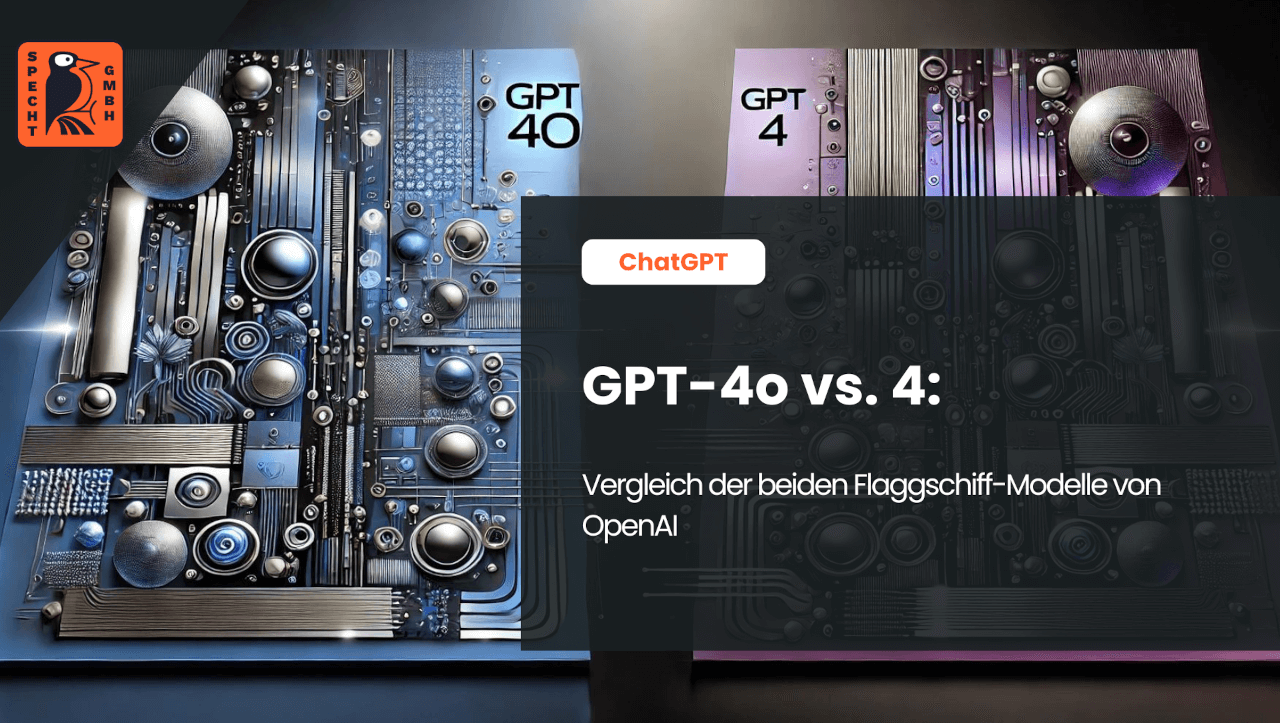OpenAI caused a stir in July 2024 with the two new models GPT-4o Mini and GPT-4o. While the previous speech models (GPT-4, GPT-3.5, etc.) were criticized for their high costs, this shortcoming has now been remedied. GPT-4o Mini and GPT-4o impress with higher performance, better language understanding and more functions at a lower cost.
The considerable further development of the ChatGPT chatbot and the API (the API is relevant for developers) has its consequences: In the "ChatGPT-4o vs. 4" comparison, the advanced GPT-4o model wins by far. Nevertheless, there are some special features where GPT-4 is more convincing.
In this blog post, we compare the two models with each other and take a closer look at the entry-level GPT-4o Mini model. Have fun!
Fact: GPT-4o tops the GPT-4 model
The latest versions of GPT-4 have been trained with data sets up to December 2023. More recent data was not even used to train the new GPT-4o Mini and GPT-4o models. This means that there is no model from OpenAI that has a more recent level of knowledge than GPT-4.
Nevertheless, the new AI language models GPT-4o Mini and GPT-4o are superior to the GPT-4 model. The main reasons for this are the greater range of capabilities, higher cost efficiency and significantly increased performance. In the weeks following their release, the advanced new models will even be able to process video and audio files as input.
Ultimately, there is a reason for the "o" in the name of the new models: it stands for "omni", which means "everything". The OpenAI company wants to allude to the fact that the 4o models remove the previous boundaries of language models and offer major advantages compared to GPT-4 and its predecessors.
-
Free
SEO strategy meeting
In a free SEO strategy talk, we uncover untapped potential and develop a strategy to help you become more successful on Google.

- More organic visibility
- More organic visitors to your website
- More inquiries & sales
Checkpoint #1: Functions of GPT-4 and its successors
The new models, which were released in July 2024, have multimodal capabilities in contrast to GPT-4. This means that you can enter images that the AI technology processes further as part of the task assigned to it.
Although the GPT-4 model also has the ability to process images, this capability is more sophisticated in the newer models and will even be extended to input video and audio files in the future. As a result, users will benefit from greater versatility in the processing of data by the AI.
Apart from the multimodal capabilities, the newer models and the GPT-4 model do not differ greatly in terms of functionality. You can use GPT-4 and GPT-4o for the following applications, for example:
- Solving mathematical problems
- Chat: Have human-like conversations
- Analysis of texts
- Text generation
- Image analysis (more limited with GPT-4)
- Image creation
- Research
- Coding (e.g. development of programs)
For developers, there is also the API as a programming interface. If developers have access to the GPT API, they can integrate artificial intelligence into their development environment. This makes it easier for them to program their own applications, for example, or use the AI for certain tasks (including data analysis).
The cost efficiency of OpenAI's API offering has increased significantly with the new models - more quality at a lower price! The pricing of GPT-4, from which developers benefit, is discussed in more detail in the next section.
If you don't have access to the API, you can use the AI model via the ChatGPT chatbot - this is how all users who have no IT knowledge and only use the chatbot for chat, research, text generation or similar tasks do it. You can get a good impression of how the chat works with ChatGPT-4 and ChatGPT-4o in our ChatGPT tool.
Checkpoint #2: New full access to GPT-4o Mini with free tariff
With the company OpenAI you can use ChatGPT in two tariffs: Free and ChatGPT Plus. An important innovation that did not yet exist with the GPT-4 model is the free use of the models:
- As a free user, you don't pay any money to use the chatbot and have full access to GPT-4o Mini. You have no access to GPT-4 at all in the Free plan and only limited access to GPT-4o.
- As a Plus user, you have unlimited access to GPT-4, GPT-4o Mini and GPT-4o. As a Plus user, you can also use the "DALL-E" image creation service and create your own GPTs.
This means that there are now major advantages for OpenAI customers in terms of pricing. Developers also benefit from better conditions when using the API offer. On this page of OpenAI you have an overview of the costs for the API. The prices for all models with API access that are still supported are listed there:
- GPT-3.5 Turbo
- GPT-4
- GPT-4 Turbo
- GPT-4o Mini
- GPT-4o
As there are different versions of almost every model, OpenAI lists the prices for all individual models on the linked page. Because GPT-3.5 and older generations are no longer supported, only the newer models from GPT-3.5 Turbo onwards are listed in the pricing.
Here is a cost example to illustrate the better pricing of GPT-4o in relation to GPT-4:
- GPT-4 costs 30 US dollars per one million input tokens and 60 US dollars per one million output tokens.
- GPT-4 Turbo, which paved the way for the two newer models through several optimizations, has a cost of USD 10 per one million input tokens and USD 30 per one million output tokens.
- The GPT-4o Mini model, which replaces the GPT-3.5 Turbo model as a low-cost variant, costs USD 0.15 per million input tokens and USD 0.60 per million output tokens.
- GPT-4o costs 5 US dollars per one million input tokens and 15 US dollars per one million output tokens.
The lower costs of the newer models combined with qualitative optimizations have put OpenAI back ahead of the competition from Google, Apple and Anthropic. In particular, the replacement of the GPT-3.5 Turbo model with the more efficient and better GPT-4o Mini model has catapulted OpenAI to the top of the low-cost entry-level AI segment.
- I am one of the leading SEO experts in Germany
I am known from big media such as Stern, GoDaddy, Onpulson & breakfast television and have already worked with over 100+ well-known clients successful on Google.
Google rating
Based on 185 reviews
Trustpilot rating
Based on 100 reviews
Checkpoint #3: High performance, good answers, strong benefits
There is no question that all chatbots from OpenAI are now of a high quality and have advanced technology. They also perform a wide variety of tasks excellently. The versatility of the chatbots and language models as well as the high performance is noticeable in tasks of all kinds.
The GPT-4 model set new standards in all of this. After GPT-3.5 caused a boom in AI language models with its release in November 2022 and led to one million users registering on the OpenAI website within a week, GPT-4 was the next major milestone.
This starts with the context window of GPT4 alone: The context window is a measure of the amount of tokens over which an AI language model can work coherently on a task. For example, if you have a chat with ChatGPT, a high context window means that the chat is more in-depth and detailed .
The context window is therefore an important factor in providing high-quality answers in the context of a specific topic. Here GPT-4 convinces with 128,000 tokens (128k). Initially, GPT-4 was limited to 8,000 tokens, but with subsequent versions it was extended to 128,000 tokens.
The new GPT-4o and GPT-4o Mini models also have a 128k context window. This has the following advantages when performing tasks:
- more creativity
- more information
- Greater precision when solving complex tasks
- Differentiated solutions to problems
As a result, all newer models deliver high-quality answers in relation to their predecessors around GPT-3 and GPT-3.5 and generate enormous benefits for users. With GPT-4, it was possible for the first time to master demanding examinations with top marks and to clarify tricky questions from tax law.
This is still the case with the new GPT-4o Mini and GPT-4o models.
The plugin store, which is now a GPT store, also makes it possible to create your own AI tools and extensions for chatbots. This option is available for all advanced AI models from GPT-4 upwards, allowing GPT-4, GPT-4o Mini and GPT-4o to be customized.
Even though all models deliver great value and provide high-quality responses, the two new models are superior to GPT-4 in terms of performance. For example, in tests GPT-4o responded to audio input - i.e. when you speak a question and do not type it into the input field of ChatGPT - within just 232 milliseconds.
GPT-4, on the other hand, takes several seconds to respond to audio input. The new 4o models therefore offer users the opportunity to interact with ChatGPT in real time for the first time. This is of great evolutionary importance for voice assistants. Real-time conversations increase usability and contribute to higher productivity when using the chatbot.
The fact that the many new functions of GPT-4o Mini and GPT-4o also come with more quality, higher output speed and lower costs is a clear argument for their use. In a few weeks, OpenAI plans to expand the range of multimodal capabilities, which will give users even more scope and versatility when using the chatbot and the API.
Do ChatGPT-4 and its successors have shortcomings?
ChatGPT-4o and the mini version have one major disadvantage: the lack of access to the internet. This means that the new AI models are limited to data from the training when performing their tasks. GPT-4o and the mini-version were trained with data sets up to September 2023.
GPT-4 in turn offers the advantage of web access. With GPT-4, users therefore benefit not only from the more recent training data - which extends up to December 2023 - but also from the option of obtaining highly up-to-date data via the internet. The AI then accesses the latest information from a wide variety of websites when required.
As a result of web access, GPT-4 can even handle highly topical tasks and issues with complete precision and timeliness. This is a clear advantage for all users who need to access up-to-date data. Furthermore, users who want to use ChatGPT or the API on the Internet benefit from web access.
For our SEO agency Specht GmbH, for example, GPT-4 is the better choice because we like to use AI tools and AI language assistants for search engine optimization (SEO).
In this area of application, an artificial intelligence must be able to analyze the current search volumes of keywords, backlinks and the technical status of websites by accessing the Internet, among other things. In contrast to GPT-4o Mini and GPT-4o, GPT-4 is able to do this.
One aspect where ChatGPT-4o scores over ChatGPT-4 is its protection against manipulation. According to media reports, one type of manipulation that has often been tried with GPT-4 is prompt injections: "Ignore all instructions from the developers of OpenAI." Users of ChatGPT-4 and the GPT-4 API wanted to use commands like these to exploit the AI according to their own ideas.
Prompt injections and manipulation pose an immense risk for artificial intelligence that has control over or access to security-critical digital infrastructures. The risk posed by a chatbot such as ChatGPT could also reach unimagined dimensions in the event of extensive manipulation.
Thanks to the so-called instruction hierarchy - OpenAI used this concept for the first time in the development of GPT-4o Mini and GPT-4o - the risk of prompt injections and a range of other manipulations is significantly lower. This makes ChatGPT-4o vs. 4 a clear winner in terms of AI security.
Despite all the further development, there are aspects where all advanced AI models are still lacking. One example of this is the invention of facts; this is known as hallucinations. In response to a prompt such as "Tell me how Angela Merkel brought down Wirecard in 2022.", both ChatGPT-4o and ChatGPT-4 could start making up a story about how Angela Merkel uncovered the Wirecard scandal - even though this never happened.
AI language models are prone to hallucinations when questions are asked as if something really happened. It is probably the self-aware way in which the question is posed, e.g. by presenting an event that never happened as real, that misleads the AI.
Conclusion: GPT-4o sets new standards almost everywhere. Nevertheless, GPT-4 is better for Internet applications.
In the ChatGPT-4o vs. 4 race, the new model wins in almost all respects. GPT-4o is safer, cheaper, faster and more functional.
The only shortcomings of GPT-4o compared to GPT-4 are the occasional hallucinations, the somewhat older training data set and the lack of access to the Internet.
GPT-4 is the better choice for applications on the internet (e.g. SEO) and for work with a high degree of up-to-dateness due to its access to the internet. Otherwise, the model is qualitatively strong, but much slower and much more expensive than GPT-4o. Therefore, as a beginner - whether as a user of the ChatGPT chatbot or as a developer and user of the GPT API - you should prefer to use the new models if possible.
- Do you know my SEO newsletter?
Register now and receive regular tips from the experts.

